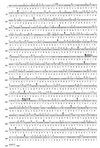A synthetic cryIC gene, encoding a Bacillus thuringiensis delta-endotoxin, confers Spodoptera resistance in alfalfa and tobacco
- PMID: 8986755
- PMCID: PMC26347
- DOI: 10.1073/pnas.93.26.15012
A synthetic cryIC gene, encoding a Bacillus thuringiensis delta-endotoxin, confers Spodoptera resistance in alfalfa and tobacco
Abstract
Spodoptera species, representing widespread polyphagous insect pests, are resistant to Bacillus thuringiensis delta-endotoxins used thus far as insecticides in transgenic plants. Here we describe the chemical synthesis of a cryIC gene by a novel template directed ligation-PCR method. This simple and economical method to construct large synthetic genes can be used when routine resynthesis of genes is required. Chemically phosphorylated adjacent oligonucleotides of the gene to be synthesized are assembled and ligated on a single-stranded, partially homologous template derived from a wild-type gene (cryIC in our case) by a thermostable pfu DNA ligase using repeated cycles of melting, annealing, and ligation. The resulting synthetic DNA strands are selectively amplified by PCR with short specific flanking primers that are complementary only to the new synthetic DNA. Optimized expression of the synthetic cryIC gene in alfalfa and tobacco results in the production of 0.01-0.2% of total soluble proteins as CryIC toxin and provides protection against the Egyptian cotton leafworm (Spodoptera littoralis) and the beet armyworm (Spodoptera exigua). To facilitate selection and breeding of Spodoptera-resistant plants, the cryIC gene was linked to a pat gene, conferring resistance to the herbicide BASTA.
Figures




References
-
- Schnepf E H. Curr Opin Biotechnol. 1995;6:305–312.
-
- Knowles B H. Adv Insect Physiol. 1994;24:275–308.
-
- Grochulski P, Masson L, Borisova S, Pusztai-Carey M, Schwartz J-L, Brousseau R, Cygler M. J Mol Biol. 1995;254:447–464. - PubMed
-
- Koziel M G, Beland G L, Bowman C, Carozzi N B, Crenshaw R, Crossland L, Dawson J, Desai N, Hill M, Kadwell S, Launis K, Lewis K, Maddox D, McPherson K, Meghij M R, Merlin E, Rhodes R, Warren G W, Wright M, Evola S V. Bio/Technology. 1993;11:194–200.
-
- Fujimoto H, Itoh K, Yamamoto M, Kyozuka J, Shimamoto K. Bio/Technology. 1993;11:1151–1155. - PubMed
Publication types
MeSH terms
Substances
Associated data
- Actions
- Actions
LinkOut - more resources
Full Text Sources
Other Literature Sources

